Duan C.G., Karelin V.Y. Abrasive Erosion and Corrosion of Hydraulic machinery
Подождите немного. Документ загружается.

This page is intentionally left blank
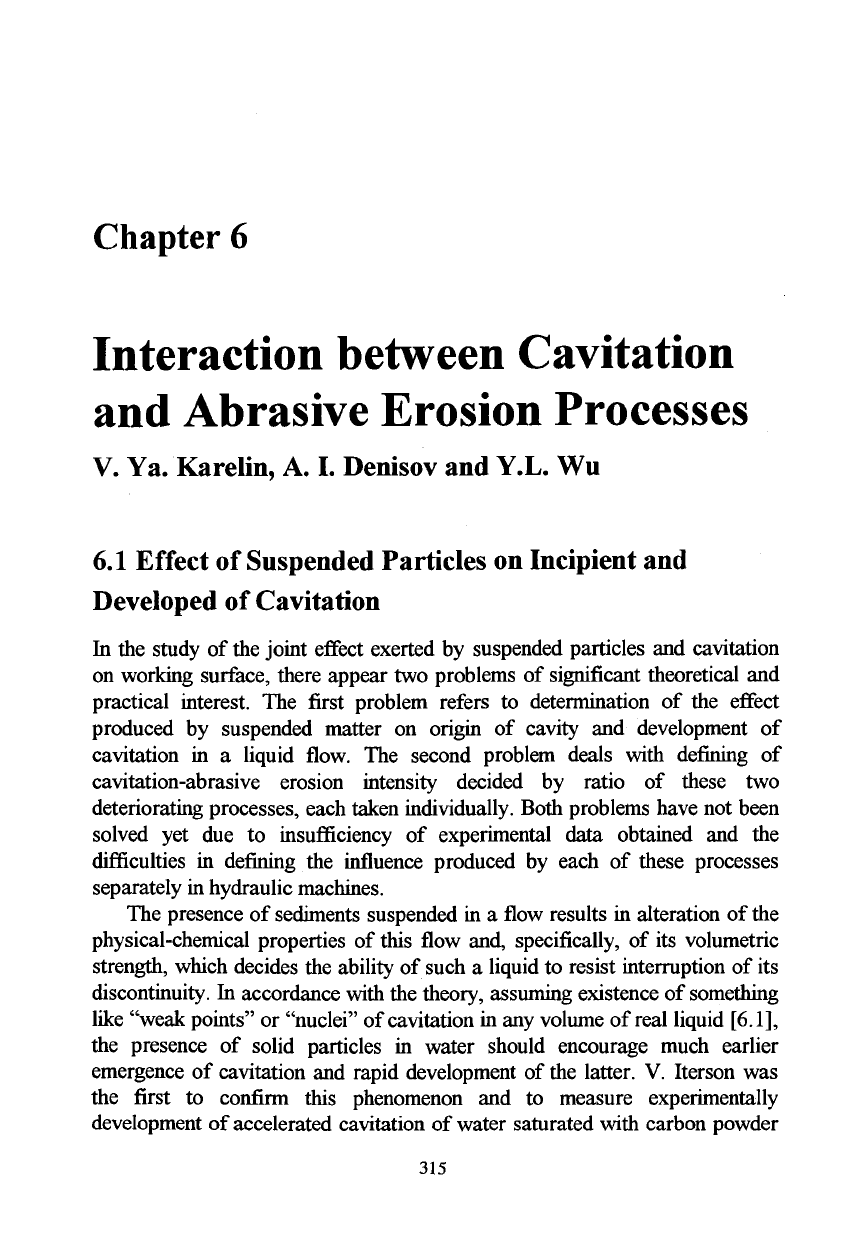
Chapter 6
Interaction between Cavitation
and Abrasive Erosion Processes
V. Ya. Karelin, A. I. Denisov and Y.L. Wu
6.1 Effect of Suspended Particles on Incipient and
Developed of Cavitation
In the study of the joint effect exerted by suspended particles and cavitation
on working surface, there appear two problems of significant theoretical and
practical interest. The first problem refers to determination of the effect
produced by suspended matter on origin of cavity and development of
cavitation in a liquid flow. The second problem deals with defining of
cavitation-abrasive erosion intensity decided by ratio of these two
deteriorating processes, each taken individually. Both problems have not been
solved yet due to insufficiency of experimental data obtained and the
difficulties in defining the influence produced by each of these processes
separately in hydraulic machines.
The presence of sediments suspended in a flow results in alteration of the
physical-chemical properties of this flow and, specifically, of its volumetric
strength, which decides the ability of such a liquid to resist interruption of its
discontinuity. In accordance with the theory, assuming existence of something
like "weak points" or "nuclei" of cavitation in any volume of real liquid
[6.1],
the presence of solid particles in water should encourage much earlier
emergence of cavitation and rapid development of the latter. V. Iterson was
the first to confirm this phenomenon and to measure experimentally
development of accelerated cavitation of water saturated with carbon powder
315
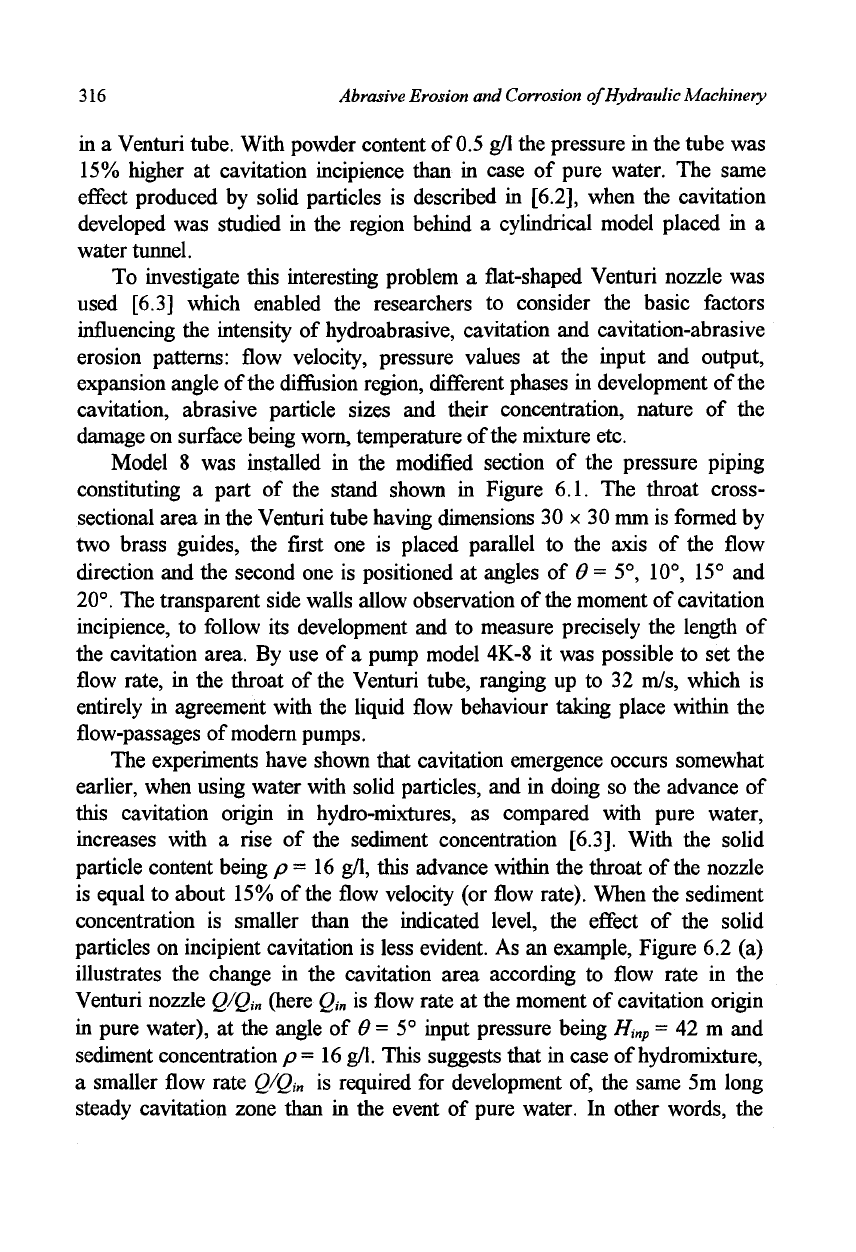
316
Abrasive Erosion and Corrosion of Hydraulic Machinery
in a Venturi tube. With powder content of 0.5 g/1 the pressure in the tube was
15%
higher at cavitation incipience than in case of pure water. The same
effect produced by solid particles is described in
[6.2],
when the cavitation
developed was studied in the region behind a cylindrical model placed in a
water tunnel.
To investigate this interesting problem a flat-shaped Venturi nozzle was
used [6.3] which enabled the researchers to consider the basic factors
influencing the intensity of hydroabrasive, cavitation and cavitation-abrasive
erosion patterns: flow velocity, pressure values at the input and output,
expansion angle of the diffusion region, different phases in development of the
cavitation, abrasive particle sizes and their concentration, nature of the
damage on surface being worn, temperature of the mixture etc.
Model 8 was installed in the modified section of the pressure piping
constituting a part of the stand shown in Figure 6.1. The throat cross-
sectional area in the Venturi tube having dimensions 30 x 30 mm is formed by
two brass guides, the first one is placed parallel to the axis of the flow
direction and the second one is positioned at angles of 9 = 5°, 10°, 15° and
20°.
The transparent side walls allow observation of the moment of cavitation
incipience, to follow its development and to measure precisely the length of
the cavitation area. By use of a pump model 4K-8 it was possible to set the
flow
rate,
in the throat of the Venturi tube, ranging up to 32 m/s, which is
entirely in agreement with the liquid flow behaviour taking place within the
flow-passages of modern pumps.
The experiments have shown that cavitation emergence occurs somewhat
earlier, when using water with solid particles, and in doing so the advance of
this cavitation origin in hydro-mixtures, as compared with pure water,
increases with a rise of the sediment concentration
[6.3].
With the solid
particle content being p
—
16
g/1,
this advance within the throat of the nozzle
is equal to about 15% of the flow velocity (or flow rate). When the sediment
concentration is smaller than the indicated level, the effect of the solid
particles on incipient cavitation is less evident. As an example, Figure 6.2 (a)
illustrates the change in the cavitation area according to flow rate in the
Venturi nozzle
Q/Q
in
(here Q
in
is flow rate at the moment of cavitation origin
in pure water), at the angle of 0 = 5° input pressure being
H
inp
= 42 m and
sediment concentration p- 16
g/1.
This suggests that in case of hydromixture,
a smaller flow rate
Q/Q
in
is required for development of, the same 5m long
steady cavitation zone than in the event of pure water. In other words, the
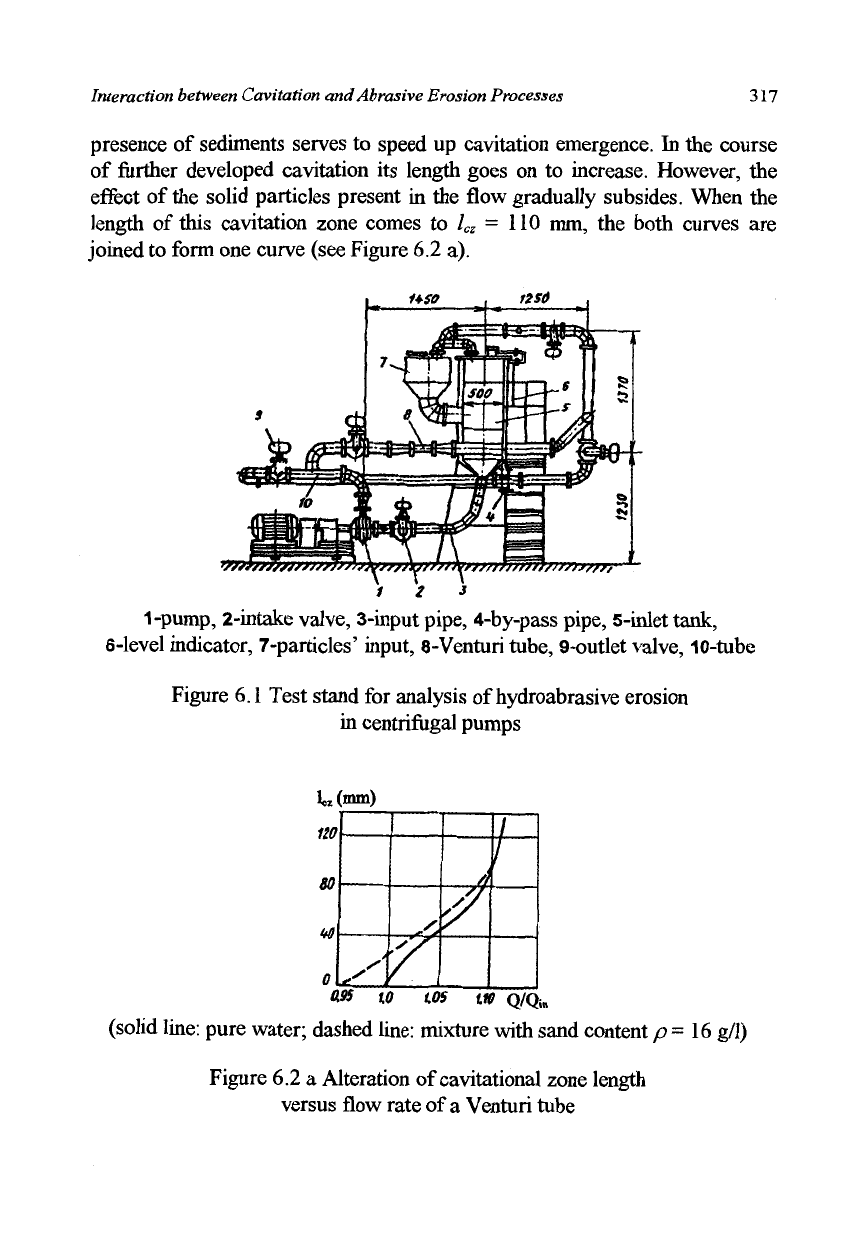
Interaction between Cavitation and Abrasive Erosion Processes
317
presence of sediments serves to speed up cavitation emergence. In the course
of further developed cavitation its length goes on to increase. However, the
effect of
the
solid particles present in the flow gradually subsides. When the
length of this cavitation zone comes to l
cz
= 110 mm, the both curves are
joined to form one curve (see Figure 6.2 a).
nso
nsd
1-pump,
2-intake
valve,
3-input
pipe,
4-by-pass
pipe,
5-inlet
tank,
6-level
indicator, 7-particles' input,
8-Venturi
tube,
9-outlet
valve,
10-tube
Figure 6.1 Test stand for analysis of hydroabrasive erosion
in centrifugal pumps
ass to w no Q/Q
in
(solid
line:
pure water; dashed
line:
mixture with sand content p
= 16
g/1)
Figure 6.2 a Alteration of cavitational zone length
versus flow rate of a Venturi tube
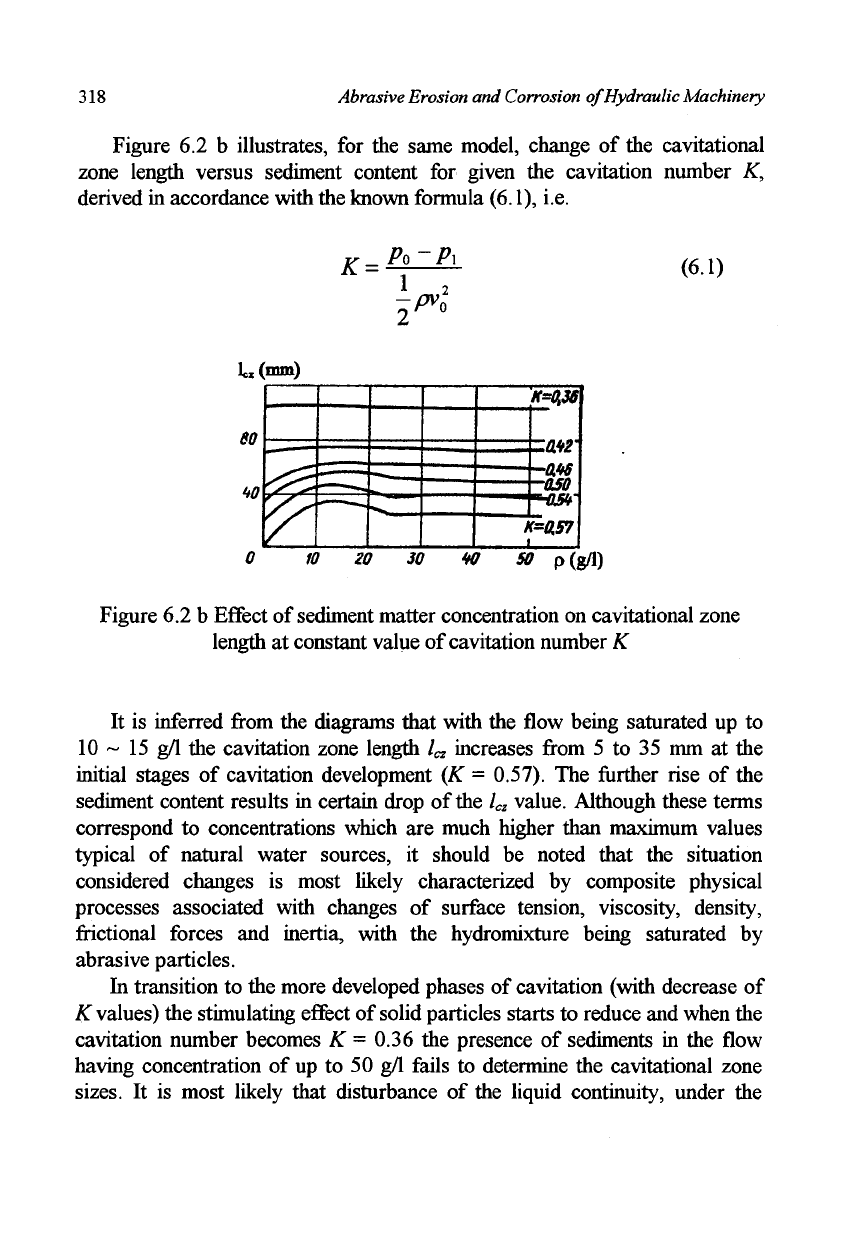
318
Abrasive Erosion
and
Corrosion
of
Hydraulic Machinery
Figure 6.2 b illustrates, for the same model, change of the cavitational
zone length versus sediment content for given the cavitation number K,
derived in accordance with the known formula (6.1), i.e.
K =
EIZ£L
(61)
1 2
1« (mm)
K=0,36
:
ZL0A2'
"-0AS
•-0S0
"-0J5V
K=a57
_.._. I
0 10 20 30 W 50 p(g/l)
Figure 6.2 b Effect of sediment matter concentration on cavitational zone
length at constant value of cavitation number K
It is inferred from the diagrams that with the flow being saturated up to
10 ~ 15 g/1 the cavitation zone length l„ increases from 5 to 35 mm at the
initial stages of cavitation development (K = 0.57). The further rise of the
sediment content results in certain drop of the l
a
value. Although these terms
correspond to concentrations which are much higher than maximum values
typical of natural water sources, it should be noted that the situation
considered changes is most likely characterized by composite physical
processes associated with changes of surface tension, viscosity, density,
frictional forces and inertia, with the hydromixture being saturated by
abrasive particles.
In transition to the more developed phases of cavitation (with decrease of
AT values) the stimulating effect of solid particles starts to reduce and when the
cavitation number becomes K
=
0.36 the presence of sediments in the flow
having concentration of up to 50 g/1 fails to determine the cavitational zone
sizes.
It is most likely that disturbance of the liquid continuity, under the
80
&
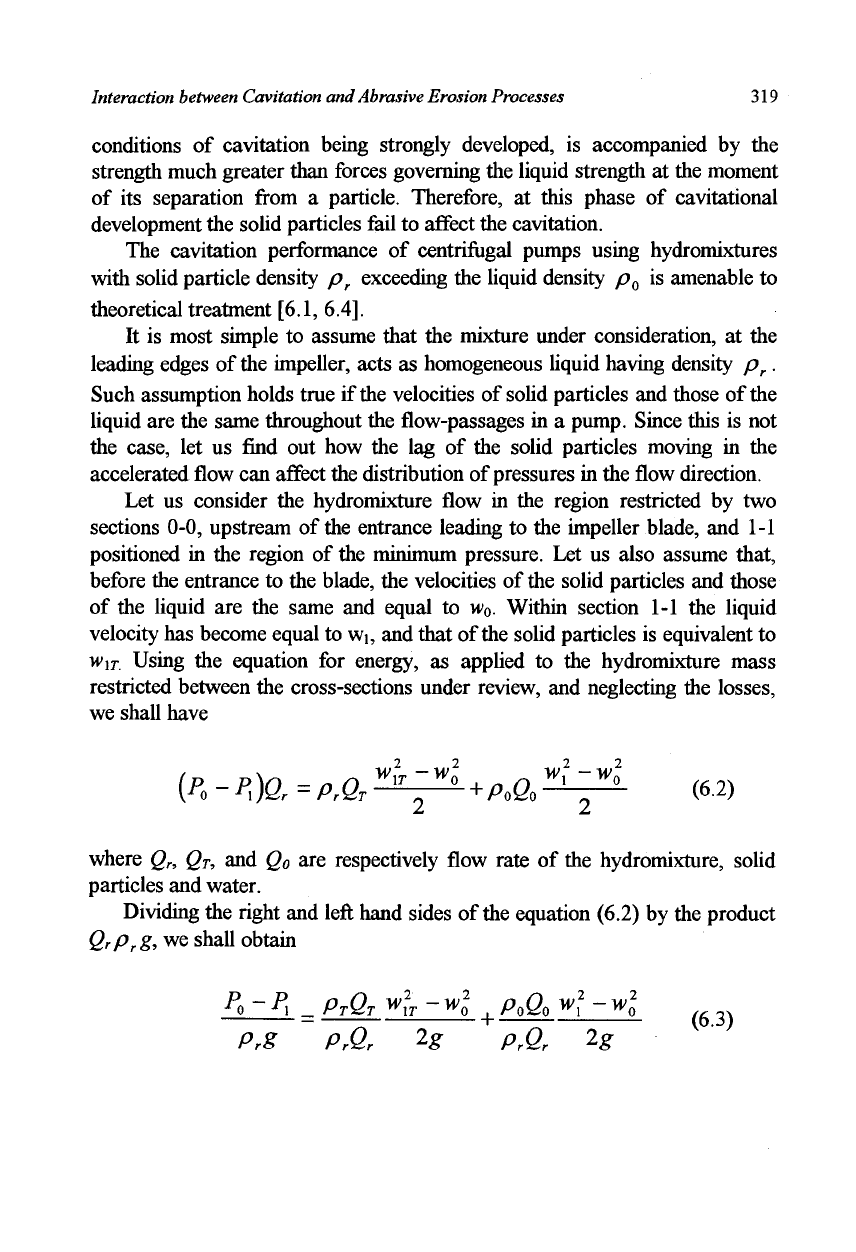
Interaction between Cavitation and Abrasive Erosion Processes
319
conditions of cavitation being strongly developed, is accompanied by the
strength much greater than forces governing the liquid strength at the moment
of its separation from a particle. Therefore, at this phase of cavitational
development the solid particles fail to affect the cavitation.
The cavitation performance of centrifugal pumps using hydromixtures
with solid particle density p
r
exceeding the liquid density p
Q
is amenable to
theoretical treatment
[6.1,
6.4].
It is most simple to assume that the mixture under consideration, at the
leading edges of the impeller, acts as homogeneous liquid having density p
r
.
Such assumption holds true if the velocities of solid particles and those of the
liquid are the same throughout the flow-passages in a pump. Since this is not
the case, let us find out how the lag of the solid particles moving in the
accelerated flow can affect the distribution of pressures in the flow direction.
Let us consider the hydromixture flow in the region restricted by two
sections 0-0, upstream of the entrance leading to the impeller blade, and 1-1
positioned in the region of the minimum pressure. Let us also assume that,
before the entrance to the blade, the velocities of
the
solid particles and those
of the liquid are the same and equal to w
0
. Within section 1-1 the liquid
velocity has become equal to Wi, and that of the solid particles is equivalent to
w
iT
. Using the equation for energy, as applied to the hydromixture mass
restricted between the cross-sections under review, and neglecting the losses,
we shall have
where Q
r
, QT, and Q
0
are respectively flow rate of the hydromixture, solid
particles and water.
Dividing the right and left hand sides of the equation (6.2) by the product
Q
r
p
r
g,
we shall obtain
P
o-P\
=
PTQT
W
IT ~
w
o , PoQo
w
f -Wo
Pr8 PrQr
^g
PrQr
^g
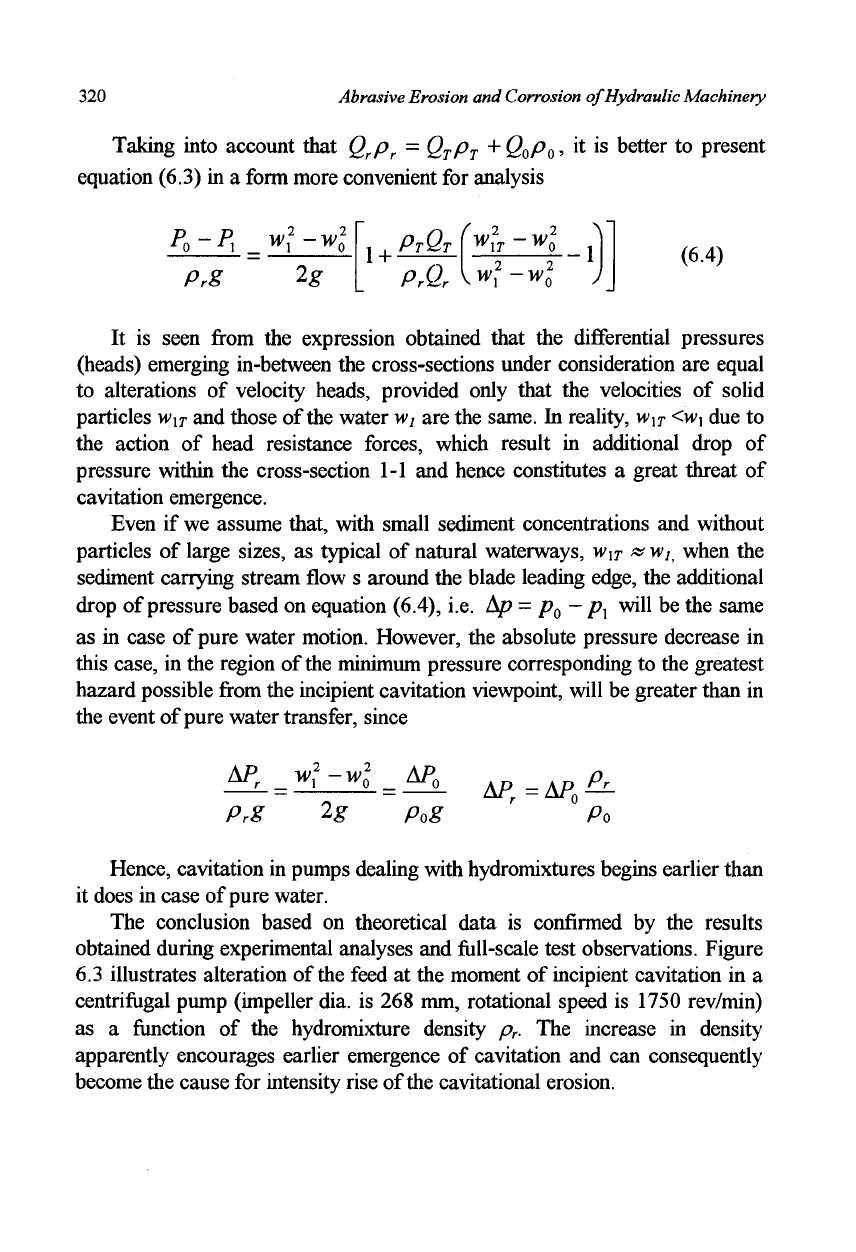
320
Abrasive Erosion and Corrosion of Hydraulic Machinery
Taking into account that Q
r
p
r
= Q
T
p
T
+
Q
0
Po
>
^ *
s
better to present
equation (6.3) in a form more convenient for analysis
P - P
Prg
w
■w:
2g
1
+
PTQT
PrQr
w
IT
■w
n
\w,
w
n
(6.4)
It is seen from the expression obtained that the differential pressures
(heads) emerging in-between the cross-sections under consideration are equal
to alterations of velocity heads, provided only that the velocities of solid
particles w
XT
and those of the water wi are the same. In reality, w\
T
<w\
due to
the action of head resistance forces, which result in additional drop of
pressure within the cross-section 1-1 and hence constitutes a great threat of
cavitation emergence.
Even if we assume that, with small sediment concentrations and without
particles of large sizes, as typical of natural waterways, W\
T
&
w;, when the
sediment carrying stream flow s around the blade leading edge, the additional
drop of pressure based on equation (6.4), i.e. Ap = p
0
- p
]
will be the same
as in case of pure water motion. However, the absolute pressure decrease in
this case, in the region of the minimum pressure corresponding to the greatest
hazard possible from the incipient cavitation viewpoint, will be greater than in
the event of pure water transfer, since
Prg
2 2
2g
**L AP
r
=AP
0
^
Pog Po
Hence, cavitation in pumps dealing with hydromixtures begins earlier than
it does in case of pure water.
The conclusion based on theoretical data is confirmed by the results
obtained during experimental analyses and full-scale test observations. Figure
6.3 illustrates alteration of
the
feed at the moment of incipient cavitation in a
centrifugal pump (impeller dia. is 268 mm, rotational speed is 1750 rev/min)
as a function of the hydromixture density p
r
. The increase in density
apparently encourages earlier emergence of cavitation and can consequently
become the cause for intensity rise of the cavitational erosion.
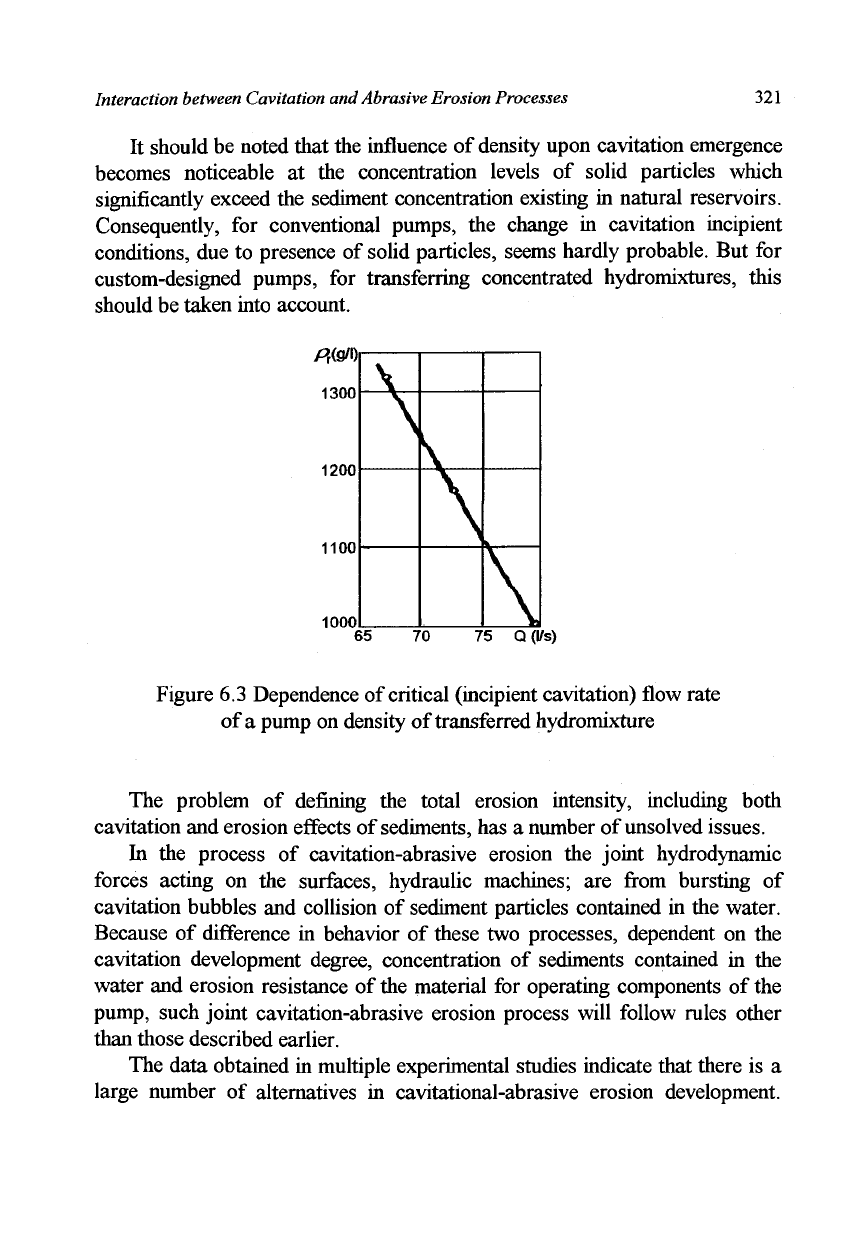
Interaction between Cavitation and Abrasive Erosion Processes 321
It should be noted that the influence of density upon cavitation emergence
becomes noticeable at the concentration levels of solid particles which
significantly exceed the sediment concentration existing in natural reservoirs.
Consequently, for conventional pumps, the change in cavitation incipient
conditions, due to presence of solid particles, seems hardly probable. But for
custom-designed pumps, for transferring concentrated hydromixtures, this
should be taken into account.
1300
1200
1100
1000
65 70 75 Q(l/s)
Figure 6.3 Dependence of critical (incipient cavitation) flow rate
of a pump on density of transferred hydromixture
The problem of defining the total erosion intensity, including both
cavitation and erosion effects of
sediments,
has a number of unsolved issues.
In the process of cavitation-abrasive erosion the joint hydrodynamic
forces acting on the surfaces, hydraulic machines; are from bursting of
cavitation bubbles and collision of sediment particles contained in the water.
Because of difference in behavior of these two processes, dependent on the
cavitation development degree, concentration of sediments contained in the
water and erosion resistance of the material for operating components of the
pump, such joint cavitation-abrasive erosion process will follow rules other
than those described earlier.
The data obtained in multiple experimental studies indicate that there is a
large number of alternatives in cavitational-abrasive erosion development.
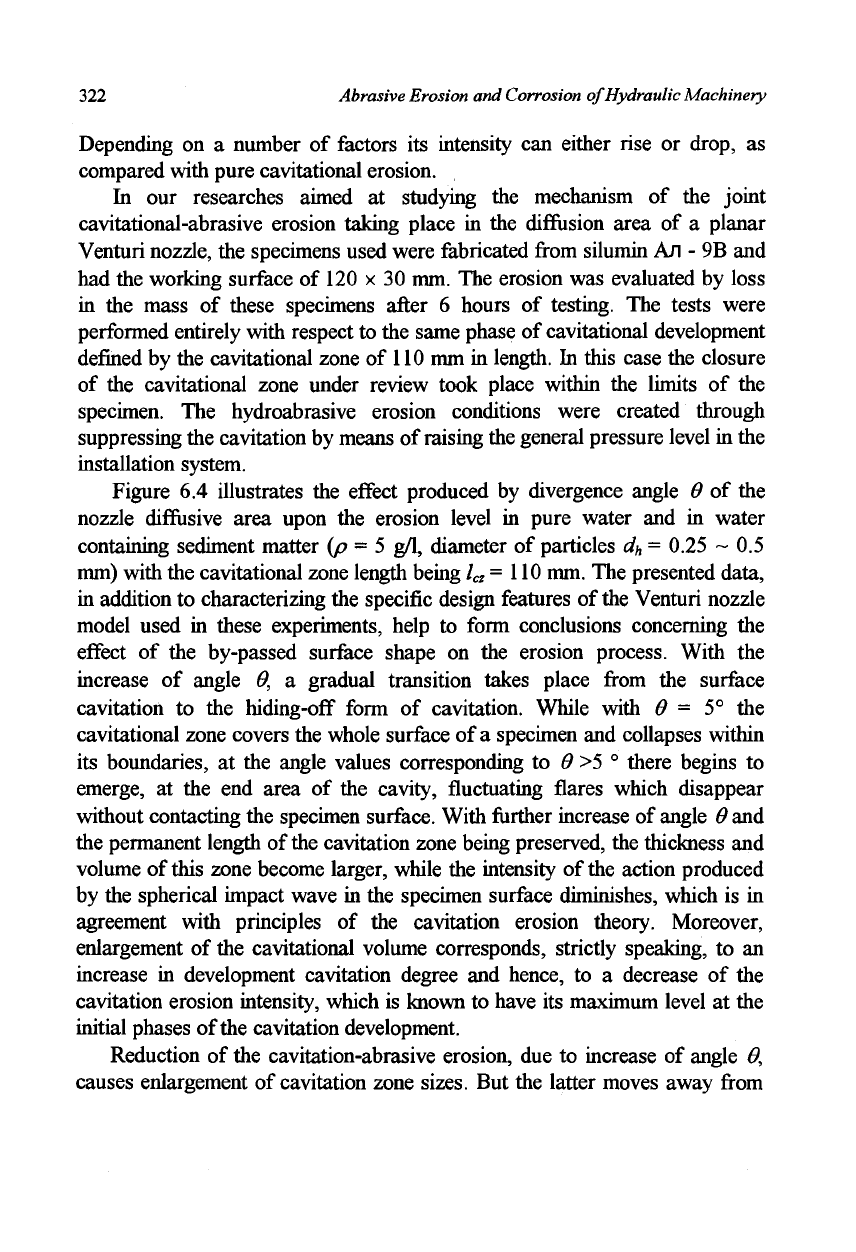
322
Abrasive Erosion and Corrosion of Hydraulic Machinery
Depending on a number of factors its intensity can either rise or drop, as
compared with pure cavitational erosion.
In our researches aimed at studying the mechanism of the joint
cavitational-abrasive erosion taking place in the diffusion area of a planar
Venturi nozzle, the specimens used were fabricated from silumin An - 9B and
had the working surface of 120 x 30 mm. The erosion was evaluated by loss
in the mass of these specimens after 6 hours of testing. The tests were
performed entirely with respect to the same phase of cavitational development
defined by the cavitational zone of 110 mm in length. In this case the closure
of the cavitational zone under review took place within the limits of the
specimen. The hydroabrasive erosion conditions were created through
suppressing the cavitation by means of raising the general pressure level in the
installation system.
Figure 6.4 illustrates the effect produced by divergence angle 6 of the
nozzle diffusive area upon the erosion level in pure water and in water
containing sediment matter (p = 5 g/1, diameter of particles d
h
=
0.25 ~ 0.5
mm) with the cavitational zone length being l
a
= 110
mm.
The presented data,
in addition to characterizing the specific design features of the Venturi nozzle
model used in these experiments, help to form conclusions concerning the
effect of the by-passed surface shape on the erosion process. With the
increase of angle 6, a gradual transition takes place from the surface
cavitation to the hiding-off form of cavitation. While with 6 = 5° the
cavitational zone covers the whole surface of a specimen and collapses within
its boundaries, at the angle values corresponding to 6 >5 ° there begins to
emerge, at the end area of the cavity, fluctuating flares which disappear
without contacting the specimen surface. With further increase of
angle
0
and
the permanent length of the cavitation zone being preserved, the thickness and
volume of this zone become larger, while the intensity of
the
action produced
by the spherical impact wave in the specimen surface diminishes, which is in
agreement with principles of the cavitation erosion theory. Moreover,
enlargement of the cavitational volume corresponds, strictly speaking, to an
increase in development cavitation degree and hence, to a decrease of the
cavitation erosion intensity, which is known to have its maximum level at the
initial phases of the cavitation development.
Reduction of the cavitation-abrasive erosion, due to increase of angle 0,
causes enlargement of cavitation zone sizes. But the latter moves away from
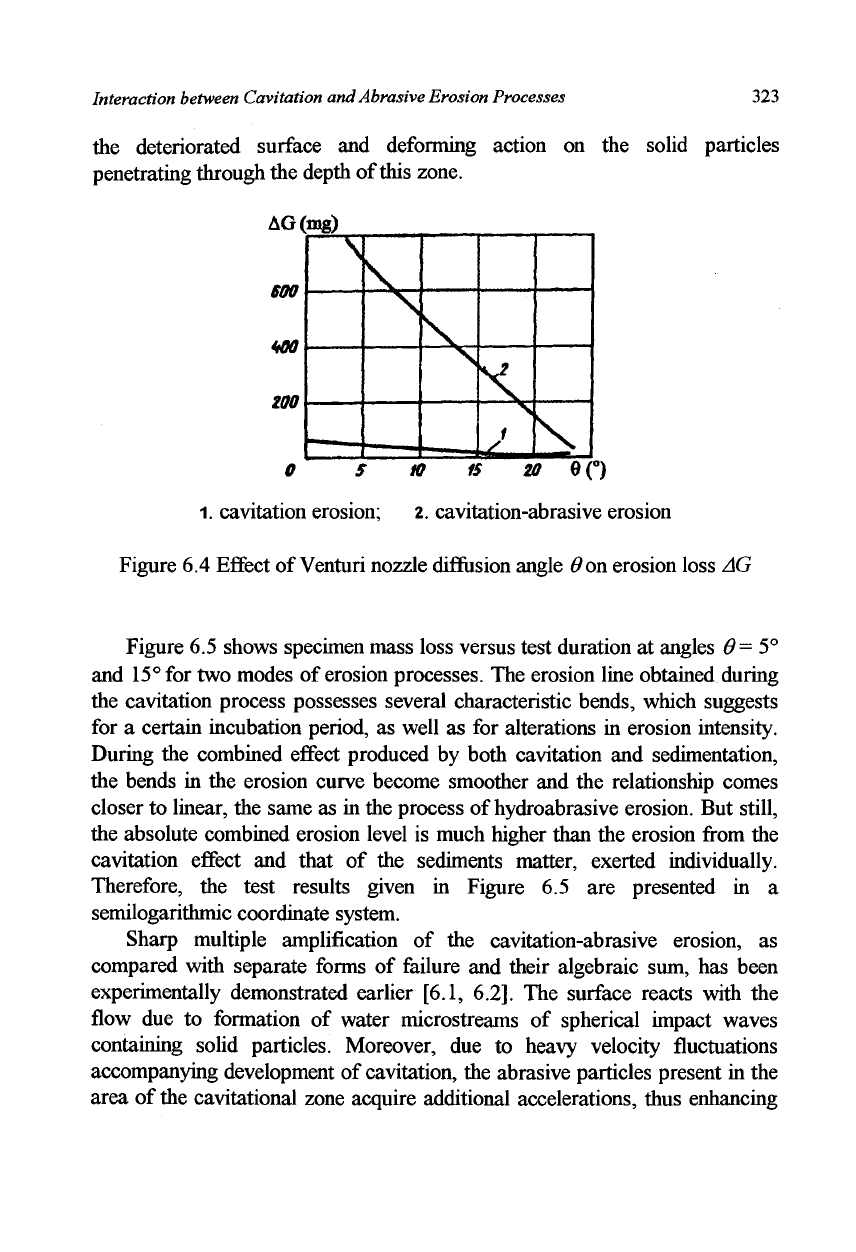
Interaction between Cavitation and Abrasive Erosion Processes
323
the deteriorated surface and deforming action on the solid particles
penetrating through the depth of this zone.
AG(mg)
600
too
ZOO
0 5 tO 15 20 Of)
1.
cavitation erosion; 2. cavitation-abrasive erosion
Figure 6.4 Effect of Venturi nozzle diffusion angle 0on erosion loss AG
Figure 6.5 shows specimen mass loss versus test duration at angles 0=5°
and
15°
for two modes of erosion processes. The erosion line obtained during
the cavitation process possesses several characteristic bends, which suggests
for a certain incubation period, as well as for alterations in erosion intensity.
During the combined effect produced by both cavitation and sedimentation,
the bends in the erosion curve become smoother and the relationship comes
closer to linear, the same as in the process of hydroabrasive erosion. But still,
the absolute combined erosion level is much higher than the erosion from the
cavitation effect and that of the sediments matter, exerted individually.
Therefore, the test results given in Figure 6.5 are presented in a
semilogarithmic coordinate system.
Sharp multiple amplification of the cavitation-abrasive erosion, as
compared with separate forms of failure and their algebraic sum, has been
experimentally demonstrated earlier [6.1, 6.2]. The surface reacts with the
flow due to formation of water microstreams of spherical impact waves
containing solid particles. Moreover, due to heavy velocity fluctuations
accompanying development of cavitation, the abrasive particles present in the
area of the cavitational zone acquire additional accelerations, thus enhancing
/
